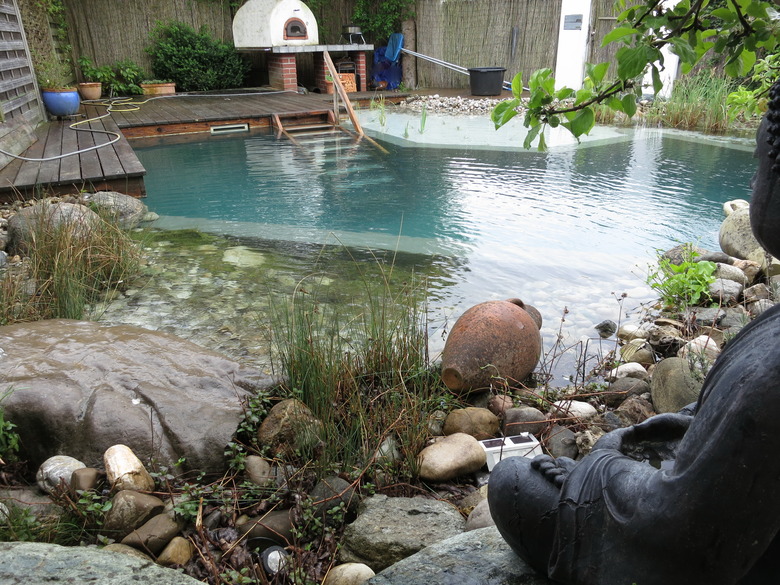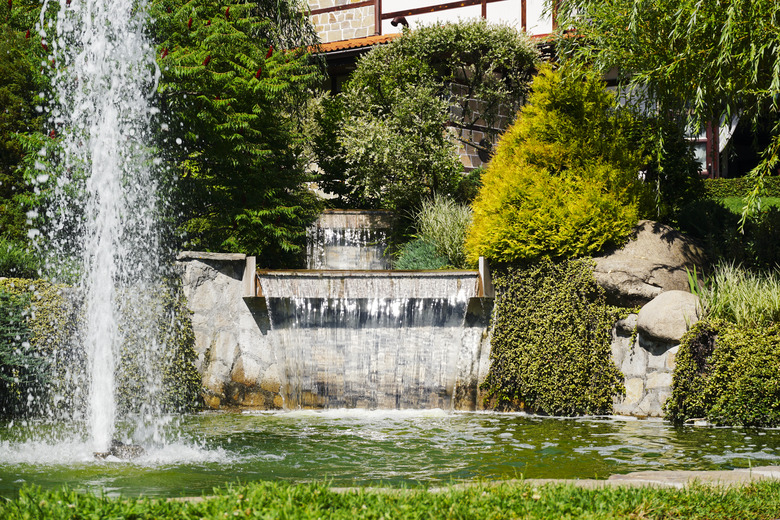What Is A Natural Swimming Pool?
You've decided to invest in an aqueous retreat from the summer heat, but you can't stand the idea of immersing yourself in a pool full of chlorinated water day after day. Does this mean you're ready to install a natural swimming pool? That depends on the amount of space you have to devote to a swimming pool, your budget and, to a lesser degree, your climate zone. A natural swimming pool could be an option, but first, you have to understand what it is.
To keep the water clean, a traditional pool relies on chlorine introduced directly into the pool water or released by a saltwater system, but a natural swimming pool takes on a two-prong purification approach that doesn't use chlorine at all. The first prong is a filtration system that removes silt and other larger particles, and the second is a living ecosystem that naturally controls microorganisms. This idea originated in Austria in the 1980s and became popular in Europe before people on the North American side of the Atlantic took interest, and it's one that continues to gain popularity.
Tip
A natural swimming pool relies on filtration by plants and algae, so it doesn't contain chlorine or any other sanitizing chemicals. The plants and water form a living ecosystem that provides a clean, healthy swimming experience.
A Natural Swimming Pool Has Zones
A Natural Swimming Pool Has Zones
Also known as organic pools, natural swimming pools are a dream for homeowners who love tending gardens and landscaping in general because maintaining a natural swimming pool is like maintaining a garden. The garden typically occupies a section of the pool separate from the swimming area known as the regeneration zone, but it's possible to design a pool in which these two zones are integrated. The regeneration zone is full of aquatic plants that compete with harmful microorganisms for nutrients, and in a balanced system, the plants outperform the pathogens and keep the water clean.
The plants perform the same purifying function as chlorine does in a conventional pool, but for them to be effective, the pool usually needs a circulation pump to keep water flowing, and it also needs a mechanical filtration system and occasional maintenance with a skimmer to handle larger debris. Filtration can take the form of a biofilter formed by plant roots supplemented by a gravel barrier through which water passes. On one side of the barrier is a living, ever-changing ecosystem that often becomes a haven for birds and small animals, and on the other side is a swimming zone filled with clean water.
Is a Natural Swimming Pool Safe?
Is a Natural Swimming Pool Safe?
Clean water isn't necessarily clear water, and the first time you see natural swimming pool water, you may be put off by the color. Instead of the azure blue you see in chlorinated pools, the water in a natural pool often has a brownish tinge, which is caused by the presence of various algae species. The algae perform a valuable filtration function, and their concentration is usually too low to cause any safety concerns. If you're in the process of designing and building the pool, there are two ways to keep algae growth to a minimum. One is to increase the size of the pool, and the other is to locate as much of the pool in the shade as possible.
Pond and pool expert Larry Carnes of Reflections Water Gardens assures homeowners that natural pools are safe — perhaps even safer than conventional pools because they contain no harmful chemicals — but safety is relative. Nothing can prevent contamination if people don't use the pool in a sanitary way or if local wildlife decide that the pool is a good place to bathe, but you can always establish rules for proper use of the pool and erect barriers to keep out snakes and other creepy crawlies if necessary. The point of a natural pool isn't to create an antiseptic bathing experience but an eco-friendly one.
Designing a Natural Swimming Pool
Designing a Natural Swimming Pool
Before you get too far in the planning process, you need to determine whether or not you have enough space for a natural swimming pool. The minimum recommended size to avoid having the pool water overrun with algae is about 500 square feet (45 square meters), and the bigger you make the pool, the fewer algae problems you'll have. Not all that area will be usable because the regeneration zone and swimming zone should be roughly equal, although depending on which plants you use and the pool configuration, you may be able to increase the ratio to 70/30 in favor of the swimming area.
The pool area itself can be rectangular or oval like a conventional pool, or it can have an irregular shape, and the deeper you make the swimming and regeneration areas, the more the beneficial microorganisms that keep the water clean will like it. A minimum depth of 3 feet is recommended, but 6 feet is better, especially if the pool is in the sun.
The bottom of the pool has to be covered with an impermeable membrane, which keeps water in the pool and prevents contamination of the pool water from the subsoil. A black plastic pond liner will work provided you tamp down the ground and remove rocks that could pierce it, and you can cover the bottom of the pool with a layer of sand to make the experience of walking on it more comfortable.
Picking and placing the plants for a natural swimming pool isn't really a DIY project unless you happen to be a horticulturalist, so you'll probably want to consult with an expert for this part of the project. The plants will be a combination of algae, which offer excellent filtration when present in moderate amounts, floating plants, submerged plants, marginal plants that grow along the side of the pool and emergent plants, which grow on dry soil and provide shelter for frogs, birds and dragonflies while adding vertical interest to your new landscape water feature.
What's Involved With Maintenance?
What's Involved With Maintenance?
People who own natural swimming pools often boast that they require less maintenance than conventional chlorinated pools. You don't need to check the chlorine levels and add chlorine or salt, much less shock the pool to raise chlorine levels sharply and kill off out-of-control algae. Once you've established the proper balance among the plant life, the ecosystem is self-regulating, much like a forest in a bottle. Most of your maintenance duties will be gardening tasks, such as pruning back overgrown plants, trimming deadwood, clearing fallen leaves and flower petals and occasionally watering plants growing in the soil around the pool.
You may not have to monitor chlorine levels, but you do have to keep an eye on pH. Pool water tends to become alkaline over time as algae consume more and more carbon dioxide, and when the pH rises above 8.2, algae growth can spike precipitously. On the other hand, rainwater is acidic, so you may notice a large drop in pH after a heavy storm or after a lot of people use the pool, and acidic water is bad for the plants.
Because an organic pool is a self-regulating ecosystem, these two tendencies may cancel out each other, but you have to be prepared to take action if they don't. You can use chemicals to regulate pH, but the most eco-friendly way to do it is to drain a substantial amount of the pool water and replace it with fresh water.
Pros and Cons of Natural Swimming Pools
Pros and Cons of Natural Swimming Pools
If you're intrigued by the idea of a natural swimming pool, you'll want to explore all the pros and cons of building and using one. The advantages are more obvious than the drawbacks.
- The pool water contains no chlorine. You won't get itchy eyes or red skin when you go for a swim, you won't need to shower afterward and you won't go around smelling like chlorine for days.
- A natural swimming pool is like a water garden in your own backyard. You'll attract all sorts of wildlife to your own personal wetland.
- You'll save on maintenance costs, although the upfront pool construction costs will probably be higher than those for a no-frills chlorinated pool.
- Unlike a chlorinated or saltwater pool, you can leave the pool uncovered in the winter and let it freeze over just as any natural body of water would. It will snap back to life when the warm weather returns, although like a terrestrial garden, it will require spring maintenance.
Some of the drawbacks of natural swimming pools have remedies, but some don't, so it's good to be aware of them before you commit to building one.
- The pool can become a magnet for mosquitoes. You can usually remedy this by keeping the water circulating, and two ways to do this are to include a waterfall or a fountain feature. Underwater circulation pumps are also effective, but because water on the edges of the pool will tend to be stagnant no matter what you do, you probably won't be able to get rid of mosquitoes altogether.
- The brownish tinge of the water and the presence of sediment on the bottom of the pool can be off-putting to someone who is used to antiseptic pool water. Just encourage that person to visualize swimming in a natural body of water, such as a lake or a small pond. This experience is no different.
- It's difficult to heat the water, not just because it's expensive but because artificially heated water may not be ideal for healthy plant growth. One workaround is to leave the black plastic pool liner uncovered so it will absorb heat from the sun.
Converting an Existing Pool
Converting an Existing Pool
It is possible to convert an existing chlorinated pool to a natural swimming pool, although no standard conversion procedure can be applied across the board. At a minimum, the conventional pool pump will probably have to be replaced with one or more smaller, less powerful pumps, and of course, a regeneration zone will have to be established. Depending on the pool design, it may be in the main part of the pool, which will then be divided into swimming and filtration zones, or it may be in a separate adjacent pool connected through an opening in the pool liner.
Converting an existing pool is not without its problems, and one of them is that the liner of a conventional pool isn't designed to hold water that contains living organisms. The organisms leave deposits on the pool surfaces that turn green and fuzzy, and they can make the surfaces dangerously slippery. You don't want to contaminate the pollutant-free living water in the pool with chemicals to dissolve or remove these deposits, so you either have to live with them or find a way to remove them manually.

